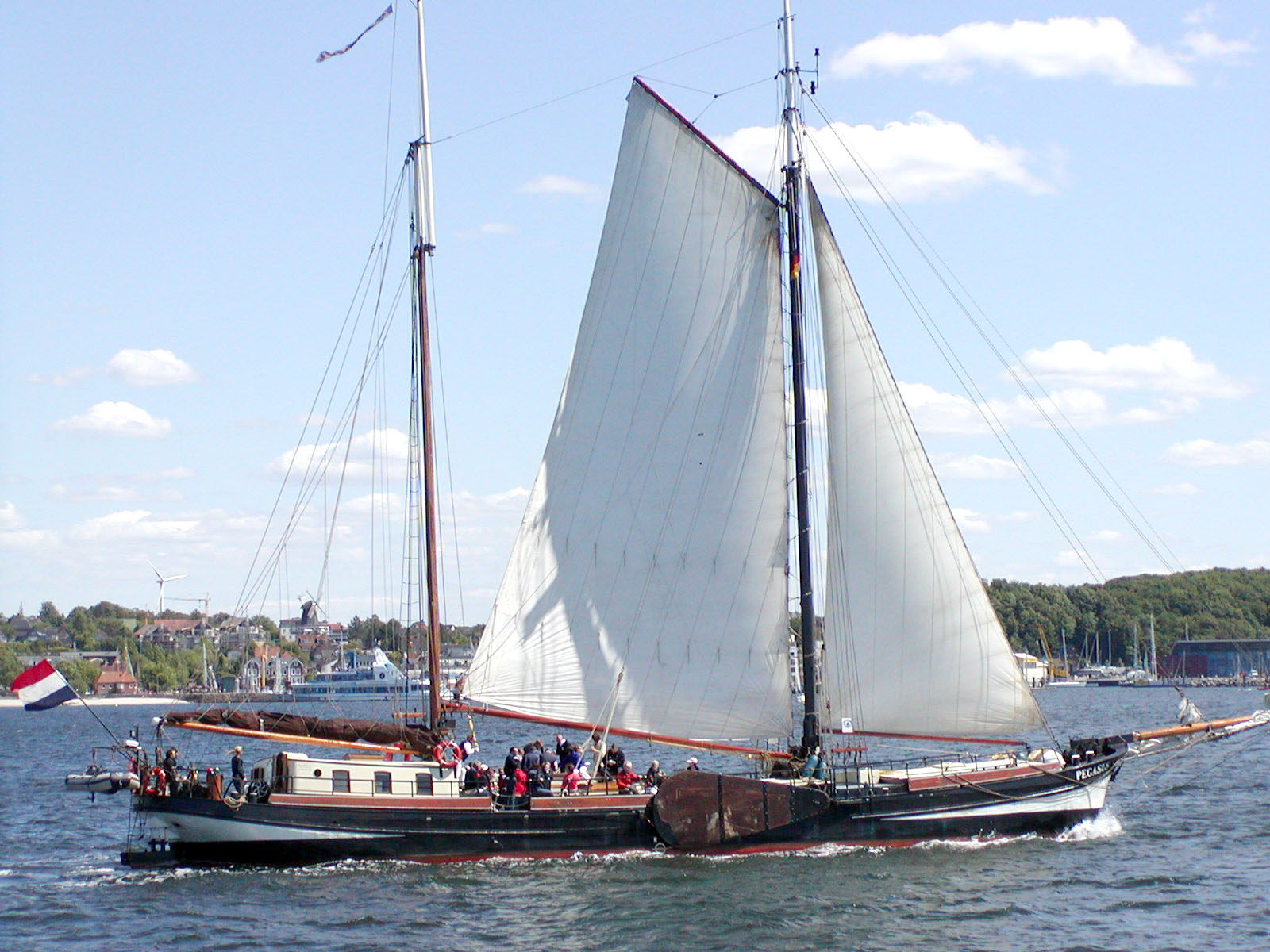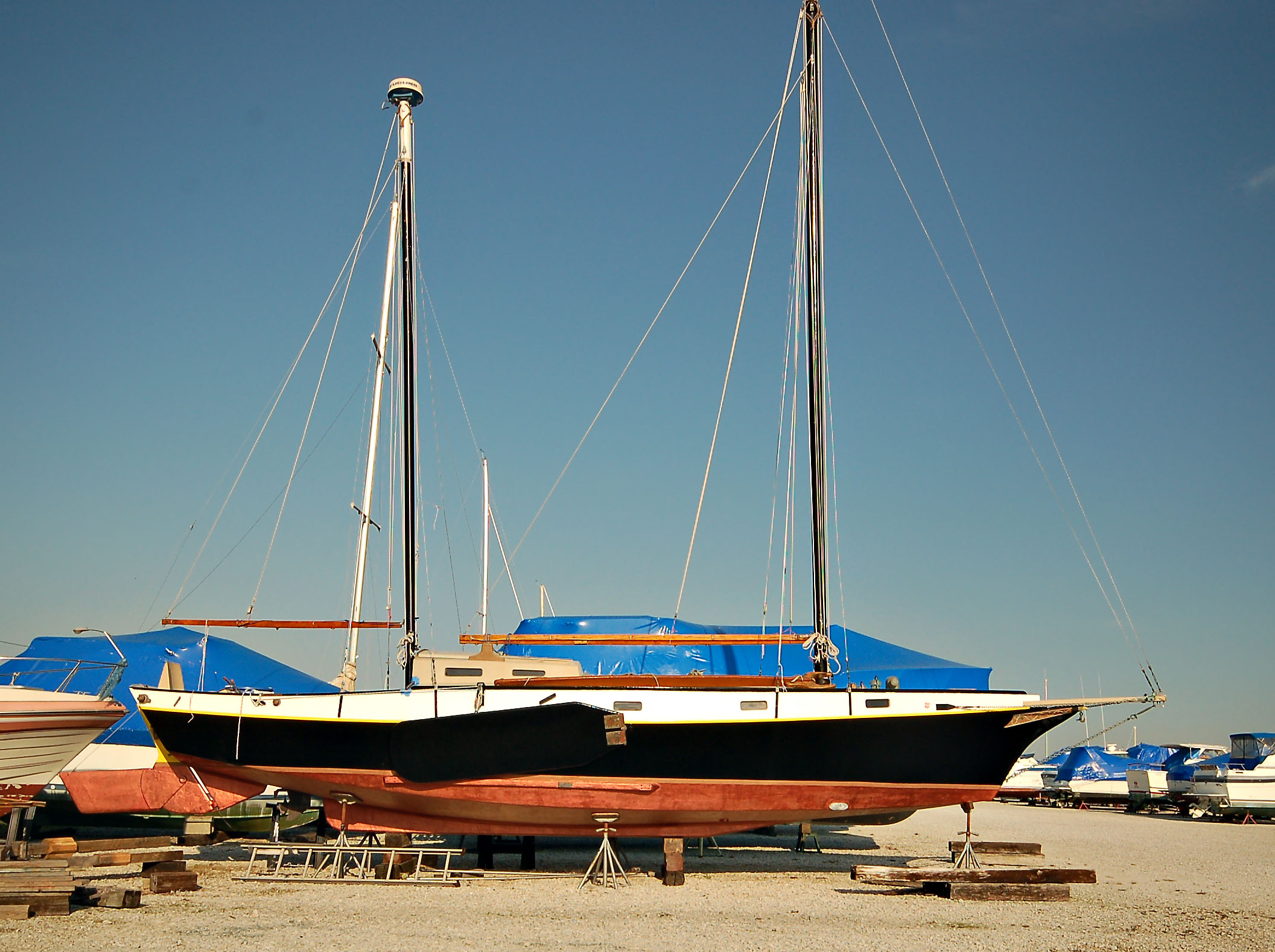Leeboard on:
[Wikipedia]
[Google]
[Amazon]


 A leeboard is a form of pivoting
A leeboard is a form of pivoting

 A leeboard is a form of pivoting
A leeboard is a form of pivoting keel
The keel is the bottom-most longitudinal structural element on a vessel. On some sailboats, it may have a hydrodynamic and counterbalancing purpose, as well. As the laying down of the keel is the initial step in the construction of a ship, in Br ...
used by a sailboat largely and very often in lieu of a fixed keel. Typically mounted in pairs on each side of a hull, leeboards function much like a centreboard
A centreboard or centerboard (US) is a retractable hull appendage which pivots out of a slot in the hull of a sailboat, known as a ''centreboard trunk'' (UK) or ''centerboard case'' (US). The retractability allows the centreboard to be raised t ...
, allowing shallow-draft craft to ply waters fixed keel boats cannot.
Only the leeward
Windward () and leeward () are terms used to describe the direction of the wind. Windward is ''upwind'' from the point of reference, i.e. towards the direction from which the wind is coming; leeward is ''downwind'' from the point of reference ...
side leeboard is used at any time, as it submerges when the boat heels under the force of the wind.
A disadvantage, where there is an inadequate fixed keel, is that they typically ship (bear) little ballast, which being on the far side delays the onset of unballasted craft's heeling, that is, to put up a good, constant resistance against the wind. The classical, archetypal definition of ballast is a low, central weight to optimise centre of mass
In physics, the center of mass of a distribution of mass in space (sometimes referred to as the balance point) is the unique point where the weighted relative position of the distributed mass sums to zero. This is the point to which a force may ...
, reduce turning moment and therefore resistance to the boat keeling over, however tends to be higher in self-righting vessels. Modern developments allow them to act as a speed-enhancing lifting foil
Foil may refer to:
Materials
* Foil (metal), a quite thin sheet of metal, usually manufactured with a rolling mill machine
* Metal leaf, a very thin sheet of decorative metal
* Aluminium foil, a type of wrapping for food
* Tin foil, metal foil ...
.
History
Leeboards existed in China from at least the eighth century on warships that "held the ships, so that even when wind and wave arise in fury, they are neither driven sideways, nor overturn". Leeboards for stabilizing junks and improving their capability to sail upwind, are documented from a book by Li Chuan. The innovation was transmitted to Portuguese and Dutch ships around 1570. "The Portuguese experimented with caulking their vessels in the Chinese manner and the Dutch probably added leeboards to their craft that were copied from Chinese models." Leeboards have been used by relatively large inshore and coastal sailing vessels used for transport since 1570, such asDutch barge
A Dutch barge is a traditional flat-bottomed shoal-draught barge, originally used to carry cargo in the shallow ''Zuyder Zee'' and the waterways of Netherlands. There are very many types of Dutch barge, with characteristics determined by region ...
s, Thames barges, and American gundalow
A gundalow (also known in period accounts as a "gondola") is a type of flat-bottomed sailing barge once common in Maine and New Hampshire rivers. It first appeared in the mid-1600s, reached maturity of design in the 1700 and 1800s, and lingered i ...
s. For these boats, leeboards provided the advantages of shallow draught for working close inshore and an unobstructed hold for cargo. In particular, they allowed gundalows to take the hard to load and unload cargo in unimproved tidal areas, as well as readily conduct maintenance on their hulls. Leeboards were also easier to build than a large centreboard would have been.
Today
Leeboards are no longer common in commercially-built boats, because many people consider them inelegant and awkward. They are far more common in home-built boats, especially thePuddle Duck Racer
A Puddle Duck Racer or PD Racer is an 8 foot (2.44 m) long, 4 foot (1.22 m) wide, 16 inch (40 cm) high, spec series, racing sailboat. It is a one design hull shape with wide options in other areas. Billed as "the easiest sailboat ...
and stitch and glue type sailboats. Leeboards simplify construction of the hull
Hull may refer to:
Structures
* Chassis, of an armored fighting vehicle
* Fuselage, of an aircraft
* Hull (botany), the outer covering of seeds
* Hull (watercraft), the body or frame of a ship
* Submarine hull
Mathematics
* Affine hull, in affi ...
, as they are attached to the outside and do not require holes in the hull, which can leak. Since centreboards are retractable, they require a large, watertight trunk to hold them in place when retracted, and this occupies what otherwise might be useful space in the cabin
Cabin may refer to:
Buildings
* Beach cabin, a small wooden hut on a beach
* Log cabin, a house built from logs
* Cottage, a small house
* Chalet, a wooden mountain house with a sloping roof
* Cabin, small free-standing structures that serve as i ...
or cockpit
A cockpit or flight deck is the area, usually near the front of an aircraft or spacecraft, from which a pilot controls the aircraft.
The cockpit of an aircraft contains flight instruments on an instrument panel, and the controls that e ...
of the boat. Use of leeboards, while it adds complexity to the process of tacking, leaves the floor of the boat unobstructed.
According to traditional design principles, a boat utilizing a leeboard either needs to have two retractable leeboards, one on each side, or a method of removing the leeboard and attaching it to either side while under way, because nearly all sailboats tack
TACK is a group of archaea acronym for Thaumarchaeota (now Nitrososphaerota), Aigarchaeota, Crenarchaeota (now Thermoproteota), and Korarchaeota, the first groups discovered. They are found in different environments ranging from acidophilic ...
to work their way upwind (with the exception of the proa
Proas are various types of multi-hull outrigger sailboats of the Austronesian peoples. The terms were used for native Austronesian ships in European records during the Colonial era indiscriminately, and thus can confusingly refer to the ...
). However, some small sailboat designers claim to have created seaworthy vessels with only a single, fixed leeboard.
On a traditional two-leeboard (or non-fixed leeboard) design, the boards are designed so that the windward
Windward () and leeward () are terms used to describe the direction of the wind. Windward is ''upwind'' from the point of reference, i.e. towards the direction from which the wind is coming; leeward is ''downwind'' from the point of reference ...
board can be retracted, to reduce drag. Unlike centreboards, which are symmetric along the boat's axis, leeboards are often asymmetric, so that they more efficiently provide lift in one direction. Some fast racing scow
A scow is a smaller type of barge. Some scows are rigged as sailing scows. In the 19th and early 20th centuries, scows carried cargo in coastal waters and inland waterways, having an advantage for navigating shallow water or small harbours. S ...
s use bilgeboards, which are mounted between the centreline of the hull and the sides, so they can use a pair of asymmetric foils for maximum lift and minimum drag.
See also
* Bruce foilReferences
External links
{{Sailing ship elements, state=expanded Chinese inventions Sailing rigs and rigging Sailing ship components